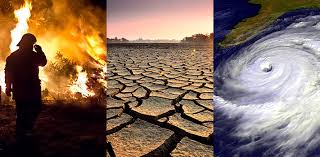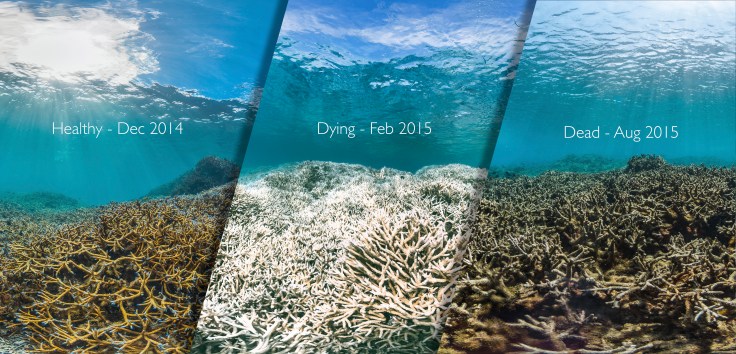
This is Part 2 of our week-long series on climate change. If you missed Part 1, you can catch it here: Millennials and Climate Change
There is TONS of evidence for climate change, way more than any blog post could contain. The few ideas I present here are a brief synopsis of vast categories. These are the TOP SIX evidences that convinced me personally of climate change, leaving behind the Protestant-Republican-Christian anti-science climate denial views I adopted as a kid.
#1. A Consensus, Scientific and Political
The consensus is real among global climate scientists. NASA surveyed the published research of climate scientists and discovered that 97% agree that a warming climate exists and is due to human activities. NASA – Consensus
“Climate change is real. There is now strong evidence that significant global warming is occurring. It is likely that most of the warming in recent decades can be attributed to human activities.” – International Science Academies
 The political consensus is also overwhelming. In 2015, every country but two adopted the Paris Accord. Nicaragua said it didn’t go far enough and Syria was in a civil war. When the USA withdrew in 2017, the remaining 195 countries doubled down on their commitment and both Nicaragua and Syria agreed to sign.
The political consensus is also overwhelming. In 2015, every country but two adopted the Paris Accord. Nicaragua said it didn’t go far enough and Syria was in a civil war. When the USA withdrew in 2017, the remaining 195 countries doubled down on their commitment and both Nicaragua and Syria agreed to sign.
The only groups you find denying climate change are political ones, generally Republican and always financed by fossil fuel industries. From the Heartland Institute on down, climate deniers do so for special interests – not from scientific evidence.
How much of this crisis is man-made? According to Dr. Gavin Schmidt of NASA:
“All of it. We look for the fingerprints of change that are associated with the sun or from volcanoes or from natural variability in the ocean and they don’t match. This is a crime scene that is so covered in our fingerprints there is no credible way that you could say it was somebody else.”
The shocking things is, none of this is “news.” In 1824, Fourier proved gasses in the atmosphere keep Earth warm. In 1859, Tyndall showed changing the concentrations of gas in the atmosphere could change climate since some block radiation while some trap it. In 1896, Arrhenius published a calculation of global warming due to our CO2 emissions. Emissions have skyrocketed since the 1800s and today continue to rise.
#2. CO2 Emissions on the Rise
 Greenhouse gases trap heat and CO2 is a major one. Humans release CO2 by breathing as well as burning fossil fuels, from driving vehicles to deforestation. The numerous livestock required to sustain human diets also contribute to the CO2 entering the air. Nature tries keeping a balance by storing carbon in plants. Think of it this way: nature locks up carbon in fossil fuels – and humans release it through various means of consumption and carelessness.
Greenhouse gases trap heat and CO2 is a major one. Humans release CO2 by breathing as well as burning fossil fuels, from driving vehicles to deforestation. The numerous livestock required to sustain human diets also contribute to the CO2 entering the air. Nature tries keeping a balance by storing carbon in plants. Think of it this way: nature locks up carbon in fossil fuels – and humans release it through various means of consumption and carelessness.
So is CO2 in the atmosphere high and increasing? We know it is. Glaciers have layers just like rock, just like trees – windows into the past. By testing air trapped in ancient glacial layers we get an idea of how high CO2 levels were in the past. The highest CO2 levels rose in known history was 300 parts per million. The level today is 407 and rising, trapping heat and raising temperatures. (NASA – CO2 Rise)
#3. Rising Temps Worldwide
 Seventeen of the eighteen warmest years on record have occurred since 2001 (NASA – Temps). Average air temperature has risen 1.8ºF in the past hundred years. If that doesn’t sound like much, it would be the same as living with a 100.4ºF fever.
Seventeen of the eighteen warmest years on record have occurred since 2001 (NASA – Temps). Average air temperature has risen 1.8ºF in the past hundred years. If that doesn’t sound like much, it would be the same as living with a 100.4ºF fever.
And that’s just an average: the poles warm even faster. In just the last half century the Antarctic air has warmed 5.4ºF. And the oceans warm even faster than the poles, as the oceans absorb 90% of heat trapped by greenhouse gases.
Your neighborhood might not feel perceptibly warmer on a daily basis. April was pretty chilly in North America but worldwide it was the 3rd warmest April… since 1880 (NOAA – April). The fact is air, land and water temps are rising around the world – leading to melting ice.
#4. Melting Ice… Worldwide for Decades
Sea ice is melting. Satellite tracking began in 1979, and the Arctic sea ice minimum has declined 13.2% per decade (NASA – Arctic). New sea routes have opened up that were once locked in ice. Just this year the Bering Strait melted earlier than ever before – since we started tracking in the 1850s (GRIST – Bering).
Antarctic sea ice has seen a similar decline, with ships traveling miles into areas old maps show were once locked in ice. I hear deniers say, “Antarctic sea ice had is greatest extent recently.” What they’re not saying is that only small areas have seen sea ice increases and are considered by scientists to be anomalies caused by stronger winds.
According to Dr. Eric Rignot, Glaciologist from UC Irvine and NASA’s Jet Propulsion Lab:
“The expansion of the sea ice in the Antarctic is related to the wind regime, which tends to extend the sea ice cover. The sea ice fools people because they think if the sea ice cover is expanding, maybe it is getting cooler there. But everything is melting. It doesn’t work that way.”
Land ice is melting. Around the world ice sheets are thinning. Areas of Greenland are losing 30 feet of ice a year (VICE – Greenland). These aren’t guesses or estimates, projections or fears. NASA has been flying since 1992 using laser altimeters to track ice thickness across the globe. These altimeters fire 3,000 shots per second and record data to track changing thickness over time. Their findings are accurate within 2 inches – not bad when measuring ice sheets that are miles thick (VICE – Antarctica).

According to Dr. Andrew Clarke, who has spent 40 years researching Antarctica and has published over 215 scholarly papers:
“There are long term temperature records from many stations and they show unequivocally that the atmosphere is warming. We have long term data from the sea showing unequivocally that the sea is warming. We have long term data on the ice showing unequivocally that the behavior of the ice is changing. It is absolutely irrefutable that the area of the West Antarctic Peninsula has a climate that is changing.”
Glaciers are melting. According to the Extreme Ice Survey (EIS – Home), Glacier National Park is down to 25 active glaciers – it had 150 in 1950. This is the norm across the globe. Surveys of of 1,400 glaciers in the Yukon Territory from 1958 to 2008 showed that 300 melted completely and 1,096 have melted partially – while only 4 grew.

If 51% of glaciers were melting for a couple years, sure – it could be natural variation. When 99.7% are consistently melting over 60 years, that’s a trend of global warmth. According to Jim Balog, founder of the Extreme Ice Survey:
“The vast majority of glaciers in the world are retreating… I never imagined you could see features this big disappearing in such a short time. I was a skeptic about climate change. I didn’t think humans were capable of changing the basic physics and chemistry of this entire huge planet.”
#5. Rising Oceans
Melting ice means rising sea levels: an estimated 9 inches in the past century according to NOAA (NOAA – Sea Level). A surprising 634 million people live near sea level, including 40% of Americans – and they’ll all need to move if oceans keep rising. Cities like Miami and Venice experience regular flooding already, and higher sea levels mean higher waves during storms – polluting fresh water sources and destroying properties.

In some areas, climate refugees are already struggling to find new land, homes and jobs. Countries like Bangladesh, the 8th most populous country in the world, are also extremely low-lying: 3.5 feet of sea level rise puts 17% of the country under water.

And there is a LOT of ice in the world. The ice on Antarctica alone could raise sea levels nearly 50 feet. Three feet would be a nightmare for dozens of countries and hundreds of islands and thousands of cities. Fifty feet would be a worldwide catastrophe. (Washington Post – Sea Level)
“Sea level rise is the one problem here there are no winners. If you have a change in rain patters, a change in temperature, somebody might be able to benefit. Sea level rise, nobody wins.” – Dr. Gavin Schmidt, NASA
#6. Dying Coral
Coral trivia: Coral reefs are not just incredibly beautiful landscapes. (Ahem, seascapes.) They form self-repairing breakers to protect shorelines. They provide food for 500 million people. They are the birth place of a quarter of ocean life, provide billions of dollars in tourism and even new pharmaceutical cures.

Also, 50% have died in the last thirty years.
In laboratory experiments, the condition discovered that could cause this rapid die off was a rise in water temperatures of 3.6ºF. In many parts of the ocean, the temperatures have risen well beyond this threshold and scientists are concerned the rest of the world’s coral doesn’t have much time. (More here: TIME – Coral)
__________________________________________________
When you put all this together, you might fairly see a bleak future. Less land, less fresh water, less food sources, less variety and beauty. More population, more pollution, more heat, extreme weather, and refugees.
But Millennials are a ridiculously hopeful bunch and they not only believe in the problem – they believe in coming together to find solutions. A first step to solving big problems is raising awareness, which is what we’ll turn to next. Why should Christians care? And why do so many Protestants Republicans doubt climate science while everyone else – including Catholics and Christian Democrats – seems to be on board? Stay tuned!
For great documentaries about many of the above topics:
“Greenland Is Melting” is available on Youtube here: VICE – Greenland
“Our Rising Oceans” is available on Youtube here: VICE – Rising Oceans
“Chasing Ice” about melting glaciers is available on Netflix
“Chasing Coral” about dying coral is available on Netflix

Join the Discussion!